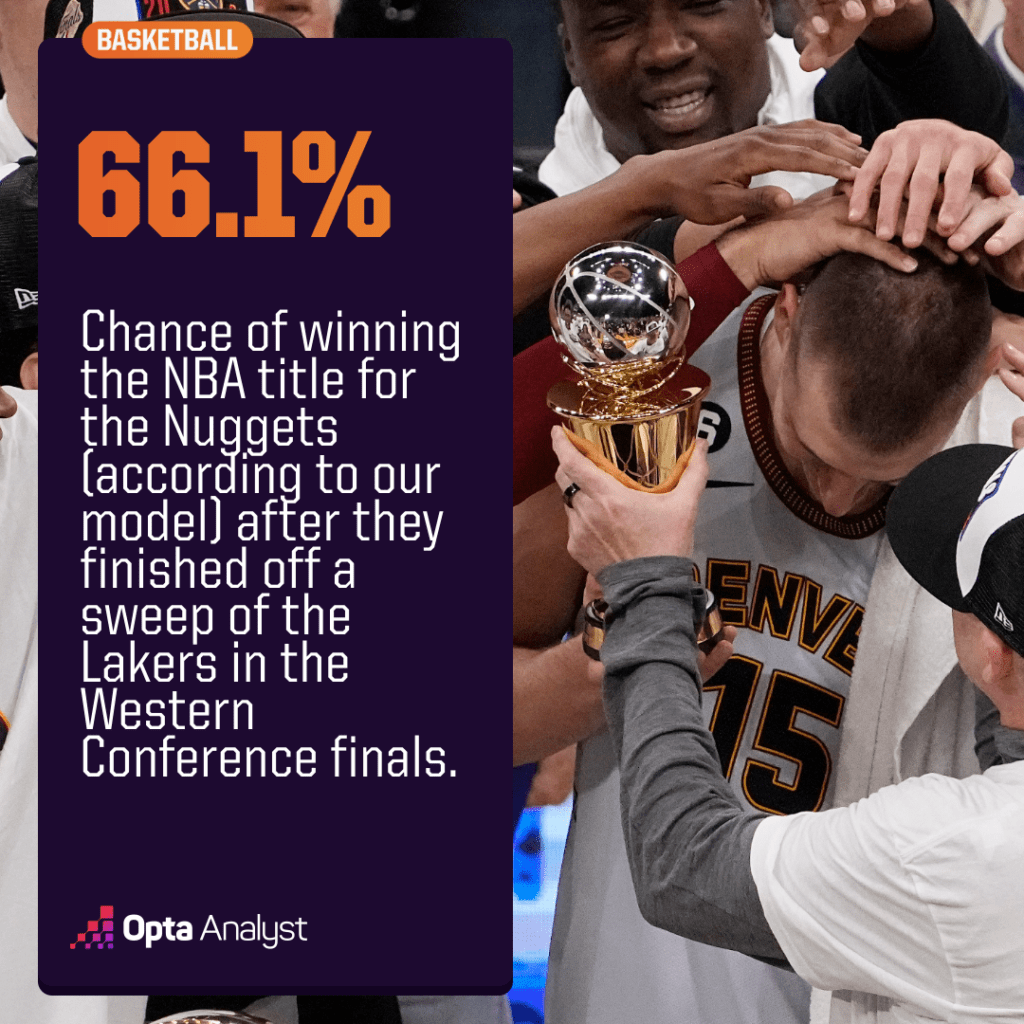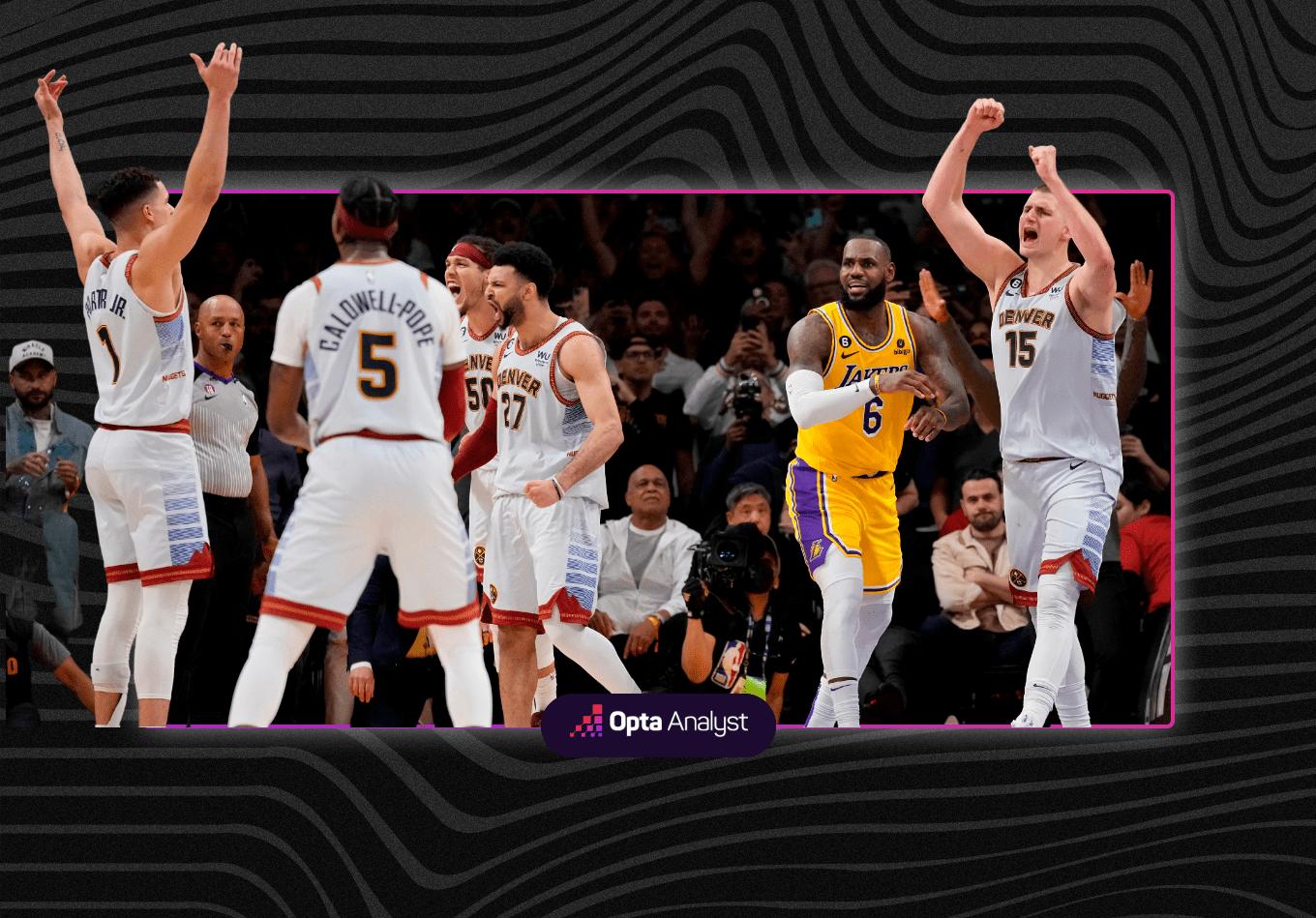The Denver Nuggets beat the Los Angeles Lakers (as our playoff projection model predicted) in sweeping fashion (ha, see what we did there), taking the Western Conference finals in four straight.
But how exactly were they able to vanquish their adversary so handedly? And what does it mean for their opponent in the NBA Finals?
No Space to Operate
One of the few constants in the Lakers’ roller-coaster season has been their lack of shooting/spacing. Even after their full-scale trade deadline makeover, Los Angeles finished the regular season 25th in the NBA in 3-point percentage (34.6%). Coming into this series, they were ranked 11th in this category out of the 16 teams that qualified for the postseason (33.1%).
On the flip side, the Lakers entered this series fourth in the playoffs in points in the paint per 100 possessions (50.0) and fifth in free throw attempts per 100 (24.0). So, the primary lifeline of their offense revolves around them scoring in the interior.
Knowing this, Denver turned to a strategy it used in the previous round against the Phoenix Suns – selling out in order to protect the paint.
By swarming the interior like this, the Lakers’ paint penetrators were forced to either take difficult shots at the rim among trees or spray the ball out to unreliable shooters.
Now, this defensive strategy didn’t exactly shut down the Los Angeles attack. The Lakers scored more points in the paint (54.4), shot more free throws (27.7), and shot a higher percentage from 3 (34.9%) than they did in the first two rounds.
However, the thing about the Nuggets is that they are an offensively slanted team. That means that their defense just needs to be passable enough to let their offense carry them to victory. By loading up the interior the way that they did, Denver slowed down the Lakers just enough to let its offense do the rest of the talking.
An Unstoppable Offensive Engine
The great playoff offenses are the ones that are versatile and resilient. These kinds of offenses can’t have their wings clipped by one or two simple defensive adjustments. You can’t just pack the paint against them and completely shut off all their faucets. They always find a way to keep the water running.
The Nuggets are a great playoff offense. Through three rounds, they boast a 119.7 offensive rating. That’s first in these playoffs by a mile (second place is the Miami Heat with an offensive rating of 117.5.
But more than any singular number can convey, they are, as we said, versatile and resilient. To understand this, let’s take a cursory glance at the chess match that played out in the Western Conference finals.
To begin the series, Denver ran a great deal of their offense through its two-time MVP. Nikola Jokić is one of the greatest offensive floor raisers in NBA history because if you try to guard him with a single defender, he’ll turn that player into mince meat. But if you send a double team his way, he’ll pick the defense apart with his playmaking. As you can probably imagine, that’s what happened to Los Angeles for most of Game 1.
The key phrase in that last sentence was “most of Game 1.” In the fourth quarter, Los Angeles used a formation known as the man-spy technique.
This alignment called for Rui Hachimura (the man) to guard Jokić while Anthony Davis (the spy) helped off of Aaron Gordon to provide backline assistance. This way, you aren’t forcing a defender to venture into Jokić Island on his own, but you also aren’t fully committing to a double team.
The Lakers continued to find success with this approach in Game 2 (even having LeBron James act as ‘the man’ in the formation at times). And as a result, Denver’s pet Jokić-centric actions were disrupted to a degree.
Many teams would need time to adapt to the new look from the defense (usually forfeiting a game in the process), but Denver’s offense stayed afloat in Game 2 by pushing the pace and attacking before Los Angeles had time to set its defense.
And late in the game, when the Lakers’ transition defense began to tighten up, Denver was able to lean on its other co-star to close the deal.
Jamal Murray isn’t the same one-man offense that his partner in crime Jokić is, but his blend of explosive scoring and tough shot-making makes him the perfect candidate to erupt and swing a playoff game on his lonesome. And that’s exactly what he did at the end of Game 2.
Murray’s hot shooting carried over to the first half of Game 3, as he scored 30 points on 13-of-20 shooting from the floor. To cool him off, the Lakers had defensive pest Dennis Schröder tail him in the second half. Schröder’s combination of fierce point-of-attack defense and slithery on-ball/off-ball screen navigation took the wind out of Murray’s sails, holding him to seven points on 2-of-9 shooting in the second half.
Again, instead of letting the cookie crumble, Denver sought points from a different revenue stream.
The Nuggets decided it was time to figure out the man-spy technique once and for all. The reason that Davis could roam in the paint without paying a tax is because Gordon wasn’t making him pay for it from outside (he shot 0 for 6 from 3 in Games 1-3). So, in an attempt to provide more spacing, coach Mike Malone decided to ride Jeff Green for the entirety of the fourth quarter.
The move to go with Green in the fourth quarter ultimately helped the Nuggets steal Game 3, but it wasn’t a permanent fix. Malone knows he’s going to need Gordon to run the table, so he had to figure out how to counter the man-spy with him on the floor.
On the other end, Lakers coach Darvin Ham’s big move for Game 4 was to start Hachimura and Schröder in place of Jarred Vanderbilt and D’Angelo Russell. To his credit, his decision helped the Lakers build a 15-point lead going into the half and kept the game close all night. However, by the fourth quarter, Denver’s offense had found multiple holes to poke in Los Angeles’ defense.
Here are a couple of examples:
- First Clip: Murray attacks the drop coverage aggressively enough to turn it into a late switch for Davis. From there, Murray flips the ball over to Gordon, who hits Jokić in the post. Jokic scores easily over Hachimura because Davis can’t execute his spy duties because he can’t afford to leave Murray.
- Second Clip: James is guarding Jokić this time (as part of the man-spy technique). Jokić sets a ball screen for Murray. The Lakers don’t want Schröder to switch on to Jokić, so they bring two to the ball. This forces Davis to rotate over to stop the rolling Jokić, which enables Gordon to slip under the rim for an easy finish.
Do you see all the different buttons Denver can push offensively?
The Nuggets have their version of heliocentrism with Jokić. They have their pace pushing (shout out Bruce Brown). They have Murray’s pick-and-roll offense. They have their different lineups they can turn to in a pinch. They have their two-man game with Murray and Jokic.
The list goes on and on.
What It Means for the NBA Finals?
Being that the Miami Heat (first in the playoffs in 3-point percentage) and the Boston Celtics (fourth) are both significantly better outside shooting teams than the Lakers, it is going to take a more sophisticated defensive scheme than the one deployed against Los Angeles to slow down those offenses.
But like we said, this Nuggets team doesn’t have to rely on a defensive masterclass to win a playoff series. It only has to hinder teams enough to let its high-octane, counter-rich offense propel it to victory. That puts a massive burden on the opposition to not only find one or two strategies that work, but to constantly come up with new creative solutions to the various problems that Denver’s offense presents.

And it’s because of that high degree of difficulty that the Nuggets impose on their opponents that makes them the favorite in this year’s NBA Finals.
Like this? Follow us on Twitter for more.
